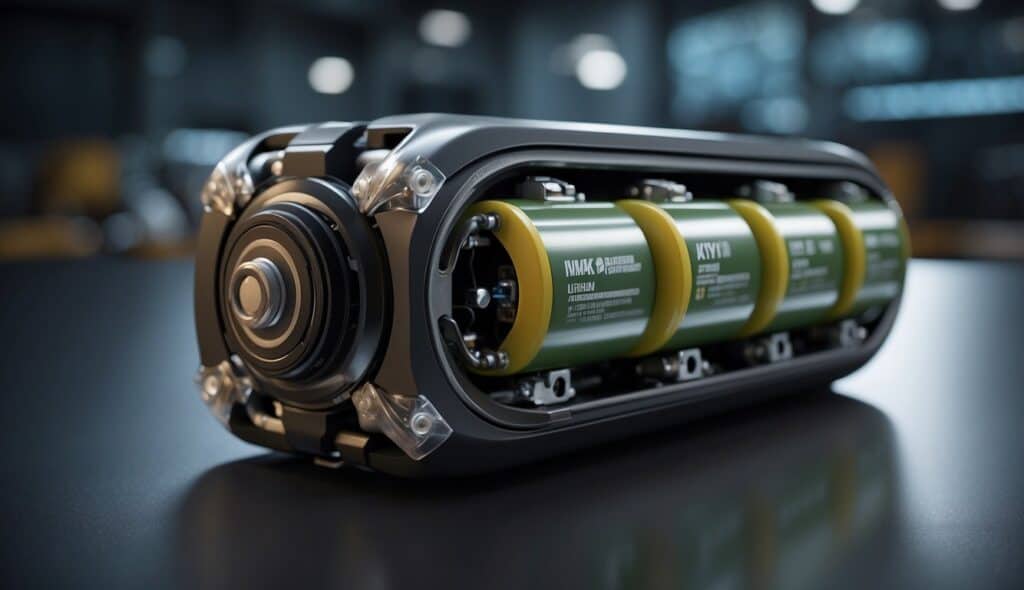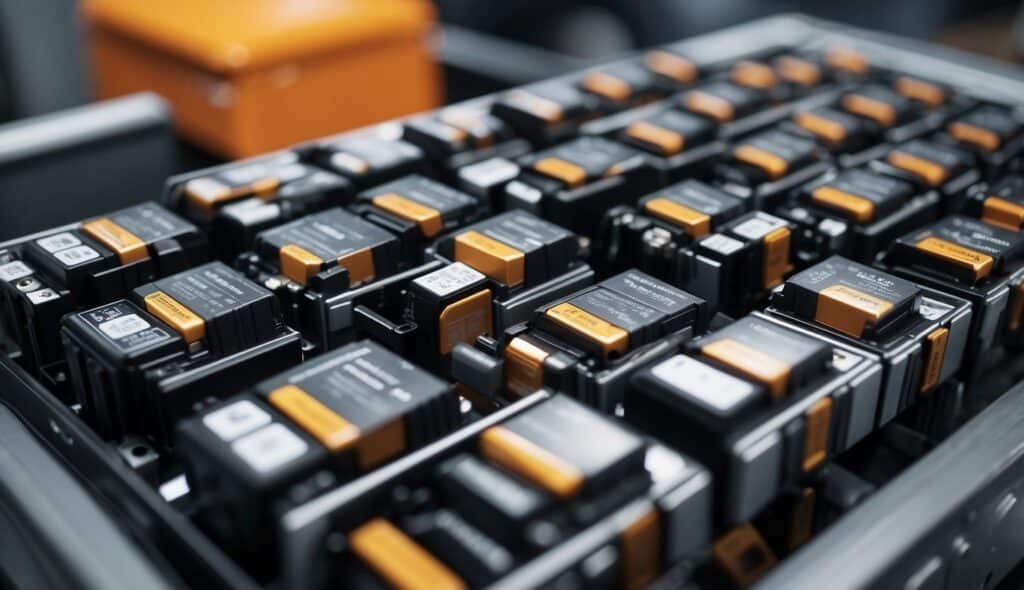Electric vehicle batteries are the heart of electric vehicles, offering the power they need to move.
The most important component of an electric vehicle battery is the cathode.
The cathode consists of key minerals like lithium, cobalt, and nickel. It determines the battery’s performance and cost, which is crucial for the efficiency and longevity of EVs.
High-performing batteries enable electric vehicles to travel longer distances on a single charge, making them more practical for everyday use.
The technology and materials used in the cathodes are constantly evolving, aimed at improving energy density and reducing charging times.
With advancements in battery technology, the range and reliability of EVs continue to improve, attracting more consumers to switch to electric.
Electric vehicles rely on sophisticated battery technology that involves the extraction and processing of valuable minerals.
Efficient battery performance is essential not only for enhancing vehicle range but also for ensuring safety and durability.
As the industry progresses, the focus remains on developing better cathodes to meet these demands.
Fundamentals of Electric Vehicle Batteries
Electric vehicle (EV) batteries are a critical component, impacting performance, range, and overall efficiency. Understanding their chemistry, structure, and management systems are key to appreciating their role and importance.

Battery Chemistry
Electric vehicle batteries primarily use lithium-ion chemistry.
This type of battery includes three main parts: the anode, cathode, and electrolyte.
The anode is usually made of graphite, while the cathode can contain different materials like nickel, manganese, and cobalt.
The electrolyte facilitates the flow of lithium ions between these electrodes during charging and discharging. Lithium-ion batteries are popular because they offer high energy density, meaning they can store a lot of energy in a small space.
Cell Types and Their Composition
Cells in electric vehicle batteries can come in various shapes and sizes.
Common types include cylindrical, prismatic, and pouch cells.
Cylindrical cells are durable and efficient, often used in consumer electronics as well. Prismatic cells are more space-efficient due to their rectangular shape. Pouch cells are lightweight and flexible, making them a good choice for maximizing space within the vehicle.
Each of these cells comprises layers of anode, cathode, and electrolyte, stacked or rolled together.
Battery Management System (BMS)
A Battery Management System (BMS) monitors and manages the health of the battery.
Its main tasks include balancing the charge across cells, preventing overcharging or deep discharging, and protecting against overheating.
The BMS ensures the battery operates safely and efficiently, extending its lifespan.
It also provides real-time data on the battery’s state of charge, health, and cycles, which is crucial for both the vehicle and the driver.
Check out How Much Electricity Does a Tesla Electric Car Use?
Critical Components Determining Performance
Electric vehicle (EV) batteries are complex systems with several critical components. Each part plays a significant role in determining the battery’s performance, capacity, and energy density.

Anodes and Cathodes
Anodes and cathodes are essential for the battery’s function.
The anode typically consists of graphite, which stores lithium ions during charging. Meanwhile, the cathode often includes materials like cobalt, nickel, and manganese.
- Graphite: Used in the anode, graphite provides a stable base for lithium-ion storage.
- Cobalt, Nickel, Manganese: Used in the cathode, these materials contribute to the battery’s energy density and performance.
Efforts to optimize these materials can improve battery life and efficiency.
Electrolytes
Electrolytes facilitate the movement of lithium ions between the anode and cathode.
Both liquid and solid electrolytes are used.
- Liquid Electrolytes: Commonly used in lithium-ion batteries, they offer high ionic conductivity.
- Solid Electrolytes: Providing safety and stability by reducing leakage and flammability concerns.
Optimizing electrolytes can enhance overall battery performance and safety.
Electrodes and Current Collectors
The electrodes are where the electric charge is stored and released. Meanwhile, current collectors, made of thin metal foils, distribute electrical currents throughout the battery.
- Electrodes: These are coated with active materials to store and release lithium ions.
- Current Collectors: Often made from aluminum (for the cathode) and copper (for the anode), they play a role in maintaining battery efficiency by minimizing energy loss.
Improving the design of these components can lead to better battery capacity and energy density.
Check Can You Charge an Electric Car in the Rain?
Safety and Reliability Concerns
Ensure their safety and reliability is crucial when it comes to EV batteries. Key concerns include how stable the batteries remain under stress and the factors that can cause them to degrade over time.
Thermal Stability and Fail-Safe Measures
The thermal stability of an EV battery is essential to prevent overheating and potential fires.
Lithium-ion batteries, commonly used in electric vehicles, are known to be sensitive to temperature changes.
The battery pack must include robust thermal management systems.
These systems use cooling techniques, such as liquid cooling or active cooling, to maintain optimal temperatures.
Installing fail-safe measures is another critical aspect.
These measures include ensuring that batteries have overcharge protection and short-circuit prevention.
One effective strategy is the use of battery management systems (BMS).
BMS monitors battery health, controlling charge and discharge rates to avoid dangerous conditions.
By employing these strategies, EV manufacturers aim to enhance the safety and longevity of the batteries.
Degradation Factors
Battery degradation is a significant concern for electric vehicles, as it affects the overall reliability and lifespan of the vehicle.
Several factors contribute to the degradation of lithium-ion batteries.
High temperatures, frequent fast charging, and deep discharges can all accelerate wear and tear.
Manufacturers must consider these factors during the design and testing phases.
They often implement specific testing protocols to assess how different conditions impact battery life.
Efforts are made to balance performance with long-term durability.
Ensuring the reliability of EV batteries involves continuous improvement and monitoring.
For example, cell chemistry advancements aim to reduce degradation rates, while battery management systems adapt to changing conditions to extend battery life.
Environmental and Economic Aspects
Electric vehicle batteries have a significant impact on both the environment and the economy. Key areas include how raw materials are sourced, the sustainability of recycling and repurposing, and the cost factors involved in battery production and usage.

Raw Material Sourcing and Sustainability
Mining for battery minerals like cobalt, lithium, and nickel has various environmental implications.
Extraction processes often lead to land degradation and pollution. For example, cobalt mining can lead to the release of toxic cobalt oxide into the environment.
Sustainable practices in the supply chain are crucial.
Efforts are being made to ensure ethical sourcing and reduce environmental damage.
Regulations and certifications aim to improve transparency in mining practices, making sure that raw materials are sourced responsibly.
The shift toward more sustainable materials and methods is driven by the need to minimize the carbon footprint.
Incorporating renewable energy in mining operations and exploring alternative materials like aluminum could mitigate some environmental issues.
Recycling and Repurposing
Battery recycling is essential for reducing waste and conserving resources.
Programs for battery recycling focus on extracting valuable minerals from used batteries.
This process not only helps in lowering the environmental impact but also reduces the demand for new raw materials.
Recycling processes are being enhanced to be more efficient and less harmful.
For example, closed-loop systems aim to reuse all components of a battery.
These systems can reclaim critical materials like lithium and cobalt, which are then reused in new batteries.
Repurposing old batteries for use in energy storage systems is another sustainable option.
This allows batteries to have a second life, reducing the need for new production and decreasing waste.
Battery Cost Considerations
The cost of electric vehicle batteries is a major factor influencing their adoption.
Battery costs have been decreasing due to advancements in technology and economies of scale.
Improvements in the supply chain and manufacturing processes largely drive price reduction.
The use of cheaper materials, like switching from cobalt to more abundant and less expensive minerals, also helps to lower costs.
Battery recycling programs contribute to cost savings.
By reclaiming and reusing materials, manufacturers can reduce production costs, making electric vehicles more affordable for consumers.
Check out Where Can I Charge My Electric Car for Free?
Advancements in Electric Vehicle Battery Technology
Recent advancements in electric vehicle battery technology have focused on improving energy density, reducing charging times, and scaling up production to meet rising demand. Key areas of innovation include solid-state batteries, new charging technologies, and overcoming challenges in battery manufacturing.
Solid-State Batteries and Future Chemistries
Solid-state batteries are a major focus in the EV industry.
These batteries replace the liquid electrolyte found in lithium-ion batteries with a solid one.
This change enhances safety, as solid electrolytes are less likely to catch fire. They also offer higher energy density, meaning electric vehicles can travel longer distances on a single charge.
Other promising chemistries include silicon anodes and lithium-sulfur batteries.
Silicon anodes can hold more lithium ions than traditional graphite anodes, potentially increasing battery capacity.
Lithium-sulfur batteries promise higher energy storage and are seen as a future alternative to lithium-ion batteries.
Innovations in Charging Technology
Advancements in charging technology are making it quicker and more convenient to recharge electric vehicles.
Fast charging stations can significantly reduce the time it takes to charge an EV.
Some new technologies aim to fully recharge a battery in just 15-30 minutes, making electric vehicles more practical for long trips.
Wireless charging is another area of development.
This technology allows vehicles to charge without being plugged in, enhancing user convenience.
Automakers are also exploring smart charging solutions that optimize charging times and reduce strain on the electrical grid.
Scaling Production and Technological Challenges
Scaling up battery production is crucial to meeting the growing demand for electric vehicles.
China is leading the way in battery manufacturing, with significant investments in new factories and technology.
Increased production capacity helps to lower costs and make electric vehicles more affordable.
However, there are technological challenges to overcome.
Sourcing raw materials like lithium and cobalt can be difficult and raises environmental concerns.
Manufacturers are working on more sustainable methods and alternative materials to address these issues.
Automation and improved manufacturing processes are also key to increasing efficiency and reducing production costs.
Check out How Long To Charge Electric Car On 110v?
Impact on Electric Vehicle Performance
The performance of an electric vehicle is greatly influenced by its battery, affecting aspects such as driving range and charging times, as well as the power-to-weight ratio and vehicle dynamics.
Driving Range and Charging Times
The driving range of an electric vehicle (EV) depends heavily on the specific energy of its battery. Higher specific energy means the battery can store more energy relative to its weight, allowing the EV to travel longer distances on a single charge.
For example, Tesla’s EVs are known for their impressive range due to advanced battery technology.
Charging times are another critical aspect. Fast-charging infrastructure can reduce wait times but often requires batteries that can handle high charging power without degradation.
Innovations in battery management systems are key to achieving faster charging while maintaining battery health.
Moreover, range anxiety remains a concern for potential EV buyers. Manufacturers must balance energy density and charging speed to enhance the user experience and make EVs more practical for daily use.
Power-to-Weight Ratio and Vehicle Dynamics
The power-to-weight ratio impacts how well an EV performs in terms of acceleration and handling. A higher power-to-weight ratio allows for better acceleration, making the vehicle more responsive.
Battery weight is a significant factor here; lighter batteries improve the overall power-to-weight ratio.
Vehicle dynamics are also affected by battery placement. Most EVs, like those from Tesla, place the battery pack low in the chassis. This lowers the center of gravity, improving stability and handling.
Additionally, the distribution of weight influences traction and cornering abilities. Properly engineered battery placement enhances these dynamics, ensuring a smoother and more controlled driving experience.
Conclusion
The most important component of an electric vehicle (EV) battery is the lithium-ion battery. This type of battery is the energy source for the vehicle, providing the necessary power to drive the motor.
Battery capacity, measured in kilowatt-hours (kWh), determines the range and performance of the EV. Most batteries range from 30 to 100 kWh. Some manufacturers offer up to 200 kWh, which extends the vehicle’s range significantly.
A critical feature is the battery management system. It monitors state of charge, temperature, and voltage. This ensures optimal performance and extends the battery’s lifespan.
Charging capabilities are also crucial. This includes fast-charging technology that can reduce charging time and make electric vehicles more convenient for users.
Regenerative braking is another vital feature. It helps to recharge the battery during braking, improving overall efficiency.
The material used in the battery also matters. Lithium-ion batteries are popular due to their high energy density and long lifespan. Yet, they come with challenges, including cost and environmental concerns.
You may also like:

Hi, I’m Marybeth, an electric car enthusiast living in New York in the USA. As the owner of electriccartalks.com, I love sharing my knowledge on EV tips, battery maintenance, and charging solutions. As a proud Tesla owner, I blend my personal experiences with professional insights to offer valuable information to fellow EV enthusiasts. Through my articles, I aim to empower others to make informed decisions about their electric vehicles. Read more